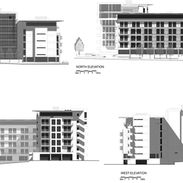
Office of the Auditor General Windhoek
Location: Windhoek, Namibia
Status: Completed
Extent:
Client: Department of Works Namibia
Completion: 2013
Located in the cultural precinct of Windhoek’s CBD, the site of the new Head Quarters of the Auditor General adjoins the busy Robert Mugabe Avenue between Bahnhof and van den Heever Streets.
Architecturally speaking, the biggest challenge was to design a building with a language and overall expression befitting the image and status of the office of an auditor general: an uncompromising and distinguished presence, yet restrained, timeless, inclusive and neutral. Other important design considerations were the contribution of the new building to public urban space within the city, and the interfacing thereof with its immediate context and the existing city fabric.
The Auditor General building complex occupies the northernmost portion of an L-shaped site, taking full advantage of the exposure offered by the prominent Robert Mugabe/van den Heever street corner. In response to the generous open urban space and garden of the FNCC across the road, the southeast corner of the site is treated as a landscaped open space planted with indigenous trees and utilised for staff parking. This gesture likewise acknowledges the presence of the nearby and historically relevant Turnhalle building.
Pavements are incorporated into the overall design, with plant boxes, trees and benches edging and punctuating pedestrian routes.
The building’s fragmented layout aims at maximising north orientation: two wings separated by a sunken courtyard garden. Public entrance to the building takes the form of a bridge suspended over the courtyard, while vertical and horizontal circulation is accommodated in the spine that connects the executive and directorate wings.
With completely open layout configurations ruled out by the confidential nature of work, offices are strung along the north and south facades ensuring ample natural light. Service spaces are located along the western façades. Parking for senior staff is located on two levels below the north wing.
External finishes are robust: face-brick, off-shutter concrete and rusted steel make for low maintenance. Fenestration is punched and largely limited to the north and south facades. Balconies allow ease of access for cleaning purposes and, along with the conspicuous brise-soleil elements and a substantial roof overhang, provide sufficient passive sun control. Equally robust, internal finishes follow a limited colour palette.





















